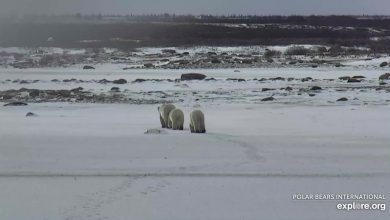Repeat of 2013 high-profile Sierra Club polar bear attack, this time with Inuit victims • Watts Up With That?

Susan Crockford
Almost 10 years later to the day, another polar bear attack resulting in serious injury has taken place in the northern Labrador/Quebec region of Eastern Canada. Remember the Sierra Club lawyer snatched, tent and all, in the middle of the night on 24 July 2013, in an almost-fatal attack that was reported around the world, see here and here? This time virtually the same thing happened to two Inuuk campers on July 26, in the same general area, as reported last week by Nunavut News. This will undoubtedly renew concerns that Davis Strait Inuit have raised about their safety in the face of high population numbers of polar bears (Tomaselli et al. 2022).
Sea ice conditions were similar in both attacks. In 2013, the attacking bear appeared to be a fully adult male in good condition that had been watching the hiking party since the previous day but this year the predatory bear was described as a small “young adult” animal, suggesting it could have been a 3-4 year old female or perhaps a 2 year old male.
Location
The Davis Strait polar bear subpopulation region encompasses most of Eastern Canada from the southeastern shore of Baffin Island to Newfoundland, as the map from the Dyck et al. 2021 report shows (see below).
The approximate locations where the attacks took place were on opposite sides of the land mass that separates Ungava Bay, Quebec from the Labrador Sea: on the Labrador Sea side in 2013, in Torngat Mountains National Park, and the Ungava Bay side in 2023, marked on a map from the first report on bears of this region (Stirling and Kiliaan 1980), where the big arrows indicate the direction of ocean currents:
2023 Attack
Quotes below are from the Nunatsiaq News report (27 July 2023). Note the community of Kangiqsualujjuaq is marked as “George River” on the map above (my emphasis):
A 70-year-old man and his son and daughter survived a polar bear attack in their tent Wednesday night [July 26] near Kangiqsualujjuaq, the village’s mayor says.
Kenny Assevak and his daughter Siqua Baron, 25, were taken to Kuujjuaq’s hospital with serious but non-life-threatening injuries. Assevak’s 35-year-old son, Neekallak Baron — who killed the bear — was not injured, said Kangiqsualujjuaq Mayor Maggie Emudluk.
It happened about 140 kilometres northeast of Kangiqsualujjuaq, where the attack victims live. At around 3 a.m. Wednesday, Emudluk received a call saying three people who were travelling toward Killiniq had been attacked by a polar bear.
That morning, thick fog covered the community, meaning helicopter rescue was out of the question.
At around 4 a.m., a boat rescue team was mobilized and at 6:15 a.m., they arrived at the scene where they took both injured victims. …
The two victims made it back to the community at around 8:15 a.m.., where both were immediately medevaced to Kuujjuaq. Assevak was then transported to Montreal for treatment of his injuries.
…
“It was not even a big polar bear,” Emudluk said, “it was a young adult polar bear.”As the Canadian Ice Service weekly stage of development chart below shows, sea ice had been present offshore as recently as the first week of July and only recently retreated from the area near the attack, which means the bear had likely only been onshore a few weeks at most. Although most polar bears are in the best condition of the year when they come off the ice, young bears are the exception.
Because young bears are unable to successfully compete with older bears for prime hunting habitat, they are likely to be in less than ideal condition in early summer and therefore most likely to initiate predatory attacks on people (Amstrup 2003; Wilder et al. 2017). A young bear was responsible for a similar early-morning fatal attack on a camper in 2020.
2013 Attack
The account summary below is from my 2014 blog post on the Torngat Mountains attack on Maine lawyer Matt Dyer, who ultimately had to be air-lifted to Montreal for medical treatment:
Seven hikers set out on a two week long adventure organized by the Sierra Club.
The mauling happened in the middle of the night of the third day, about 2:30am, despite the electric perimeter fence they had in place.
The group assumed the bear that attacked the victim (Matt Dyer) was the same big male that had advanced on their campsite the afternoon before. The bear had come within 30-50 yards but retreated when the group fired some flares at it. But the bear stayed nearby, watching.
The hikers knew he was there but apparently were not especially concerned. The bear attacked Dyer tent and all: it just pounced on the one-man tent and hauled the whole package away down the beach. The other hikers fired off some flares. The bear dropped Dyer and left.
The bear was not pursued in the days afterward and was not shot.
As the ice chart below shows, sea ice had only retreated from the Labrador coast at the time of the attack, since thick ice was still present offshore during the first week in July:
Most odd about this 2013 account is that no photos of the bear that attacked Dyer have ever been made public. I find it implausible that no photos exist, given the circumstances, but quite possible that the group agreed to suppress any images taken of the bear because it was in excellent condition and not the starving polar bear of the climate change narrative they later concocted (Crockford 2015).
Polar bears reestablishing former northern Labrador territory
Back in the 1970s, when polar bear numbers in Davis Strait were low (Stirling and Kiliaan 1980), there were few records of bears spending the summer and denning along the shores of northern Labrador and northeast Ungava Bay, Quebec, see circled region on map below.
However, according to the latest survey, that has changed now that the population has rebounded (Crockford 2023; Dyck et al. 2021; Peacock et al. 2013). The island in the middle of Ungava Bay is a major denning area for pregnant polar bears and some may now den along the mainland coast as well.
References
Amstrup, S.C. 2003. Polar bear (Ursus maritimus). In Wild Mammals of North America, G.A. Feldhamer, B.C. Thompson and J.A. Chapman (eds), pg. 587-610. Johns Hopkins University Press, Baltimore.
Crockford, S.C. 2015. “A Harrowing Encounter.” Range Magazine, Spring: 42-43.
Crockford, S.J. 2023. The Polar Wildlife Report. Global Warming Policy Foundation Briefing 63, London. pdf here.
Dyck, M., Dunham, K.D., Ware, J.V., et al. 2021. Re-estimating the abundance of the Davis Strait polar bear subpopulation by genetic mark-recapture. Final Report [amended 9 May 2022], Government of Nunavut, Department of Environment, Iglulik. pdf here.
Peacock, E., Taylor, M.K., Laake, J., and Stirling, I. 2013. Population ecology of polar bears in Davis Strait, Canada and Greenland. Journal of Wildlife Management77:463–476.
Stirling, I. and Kiliaan, H.P.L. 1980. Population ecology studies of the polar bear in northern Labrador. Occasional Paper 42, Canadian Wildlife Service. pdf here.
Tomaselli, M., Henri, D., Pangnirtung Hunters and Trappers Organization, et al. 2022. Nunavut Inuit Qaujimajatuqangit on the health of the Davis Strait polar bear population. Final project report, Government of Nunavut. pdf here.
Wilder, J.M., Vongraven, D., Atwood, T., et al. 2017. Polar bear attacks on humans: implications of a changing climate. Wildlife Society Bulletin 41(3):537-547. https://doi.org/10.1002/wsb.783





